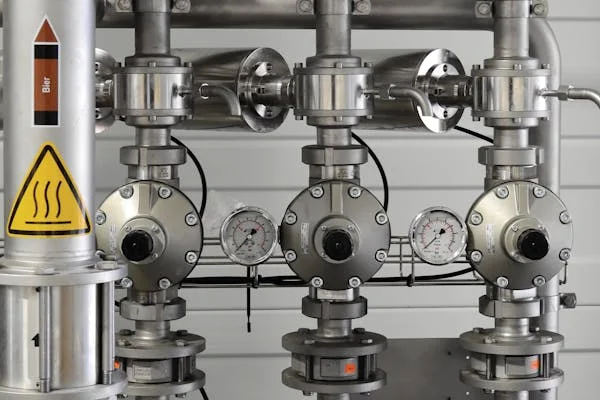Introduction
The DEKRA VT1000 is more than just an inspection tool; it represents a significant leap forward in ensuring both safety and accuracy in industrial inspections. By offering features such as high-definition imaging, explosion-proof safety, and rugged construction, it enables industries to improve their inspection processes and mitigate risks effectively.
The Evolution of Industrial Inspection Tools
Understanding the Explosion-Proof Certification of the DEKRA VT1000
One of the standout features of the DEKRA VT1000 is its explosion-proof certification. In many industries, including oil and gas, chemicals, and pharmaceuticals, workers are often exposed to flammable substances, making safety a top priority. Let’s take a deeper look at what explosion-proof certification means and why it’s crucial for tools like the VT1000.
What Does Explosion-Proof Certification Mean?
Explosion-proof certification ensures that the DEKRA VT1000 has been designed and tested to prevent ignition of surrounding gases or vapors, even if the device malfunctions. This makes it safe to use in areas where combustible materials may be present, such as refineries, chemical plants, and mining operations. The camera’s explosion-proof certification is in compliance with international safety standards, such as ATEX Zone 1, which is critical in ensuring the safety of workers and preventing accidents.
DEKRA VT1000 vs. Traditional Inspection Methods
Traditional inspection methods, like manual checks and basic visual assessments, have their limitations, especially in hazardous environments. With the DEKRA VT1000, inspections are more thorough, faster, and safer. Here’s a comparison between traditional methods and the VT1000:
Advantages of Using the DEKRA VT1000 Over Manual Inspections
- Safety: The VT1000 can be operated remotely, eliminating the need for inspectors to enter hazardous zones.
- Accuracy: With its high-definition imaging and zoom features, the camera can detect issues that might go unnoticed during manual inspections.
- Efficiency: The VT1000 allows for faster inspections, reducing downtime and improving productivity.
How the DEKRA VT1000 Improves Remote Inspections
The VT1000’s remote inspection capabilities provide a significant advantage in high-risk environments. Inspectors can assess machinery, infrastructure, and systems without being physically present, which is crucial for minimizing exposure to hazardous materials.
Key Features That Enhance Remote Inspections
- Wireless Connectivity: The VT1000 can be connected to remote viewing systems, allowing operators to view live footage and data on a monitor from a safe distance.
- Real-Time Monitoring: The camera enables real-time monitoring of inspections, making it easier to track progress, capture footage, and make adjustments to the inspection process.
Applications in Hazardous Environments: Real-World Scenarios
The DEKRA VT1000 excels in environments where worker safety and accuracy are paramount. Some of the industries that benefit from its advanced features include:
1. Oil and Gas
The oil and gas industry is one of the most hazardous industries in the world. The VT1000 is designed to operate safely in explosive atmospheres, providing crucial inspection data for oil rigs, pipelines, and refineries.
2. Chemical Processing
Chemical plants often deal with volatile substances, making it essential to have safe and reliable inspection equipment. The DEKRA VT1000 ensures that inspectors can safely perform routine checks, from storage tanks to reactors, without compromising safety.
3. Nuclear Power Plants
In nuclear power plants, safety is the top priority. The VT1000 allows for inspections in areas that may be difficult to access, such as reactors or containment areas, without putting workers at risk of exposure.
Key Industries Benefiting from the DEKRA VT1000
While the VT1000 is beneficial in many sectors, certain industries derive particular value from its capabilities.
1. Pharmaceutical Industry
Pharmaceutical plants require rigorous inspections to meet regulatory standards. The DEKRA VT1000’s precise imaging and explosion-proof design make it an excellent tool for inspecting equipment, storage units, and pipelines used in drug manufacturing.
2. Food and Beverage Manufacturing
In the food and beverage industry, hygiene and safety are critical. The VT1000 helps ensure that production lines and storage facilities are free from defects, leaks, or contaminants, which could lead to safety or quality issues.
How the DEKRA VT1000 Helps with Predictive Maintenance
Predictive maintenance is an essential strategy for preventing equipment failure and minimizing downtime in industrial operations. The VT1000 aids in this process by providing clear visuals of machinery and infrastructure, allowing operators to spot potential issues before they become significant problems.
Benefits of Predictive Maintenance with the VT1000
- Early Detection: Detects small issues such as cracks, wear, or corrosion before they cause major failures.
- Cost Savings: By addressing problems early, businesses can avoid costly repairs and unplanned downtime.
- Extended Equipment Life: Regular inspections using the VT1000 can extend the lifespan of critical machinery.
How to Integrate the DEKRA VT1000 into Your Workflow
Implementing a new tool like the DEKRA VT1000 requires strategic planning. Here’s how companies can seamlessly integrate it into their inspection workflows:
1. Training Your Team
Proper training is crucial for ensuring the VT1000 is used to its full potential. Operators should undergo training to familiarize themselves with the camera’s features, such as zoom capabilities, image quality adjustments, and safety protocols.
2. Standardizing Inspection Protocols
To ensure consistency and quality, businesses should integrate the DEKRA VT1000 into their existing inspection protocols. This might include creating checklists, setting benchmarks for image quality, and defining regular inspection schedules.
The Future of Industrial Inspections with DEKRA VT1000
Looking ahead, the role of advanced tools like the DEKRA VT1000 in industrial inspections is expected to grow. As industries continue to prioritize safety and efficiency, the demand for explosion-proof, high-definition, and remotely operated inspection cameras will increase.
Upcoming Features and Innovations
The DEKRA VT1000 is likely to continue evolving to meet the ever-changing needs of industrial inspections. Future upgrades may include AI-powered analytics, improved connectivity features, and enhanced battery life, making it an even more valuable tool in industries worldwide.
Conclusion:
In industries where safety is a top priority, the DEKRA VT1000 provides a reliable and efficient solution for conducting high-quality inspections. Its explosion-proof design, combined with high-definition imaging, durability, and user-friendly features, makes it the ideal choice for hazardous environments. With its ability to detect issues early, reduce downtime, and enhance safety, the VT1000 is a critical tool for modern industrial inspections, helping businesses meet safety standards and improve operational efficiency.
By integrating the DEKRA VT1000 into inspection workflows, companies can improve their maintenance strategies, increase compliance, and ensure the longevity of their equipment, all while minimizing risks. As industries continue to evolve, the VT1000 will remain a leading choice in industrial inspection technology.
FAQs
What is the DEKRA VT1000 used for?
The DEKRA VT1000 is an explosion-proof inspection camera for hazardous environments, providing high-definition imaging for industrial safety inspections.
How does the explosion-proof feature work?
It prevents ignition of surrounding gases or vapors, ensuring safe operation in explosive atmospheres.
Can the VT1000 be used for remote inspections?
Yes, it supports wireless connectivity for remote live footage viewing.
What industries benefit from the VT1000?
Oil and gas, chemical processing, nuclear power, and pharmaceuticals benefit from its explosion-proof design and advanced inspection features.
How does the VT1000 support predictive maintenance?
It detects small issues early, helping prevent failures and reduce downtime.
Is the VT1000 easy to integrate into workflows?
Yes, it can be easily incorporated with staff training and standardized inspection protocols.




